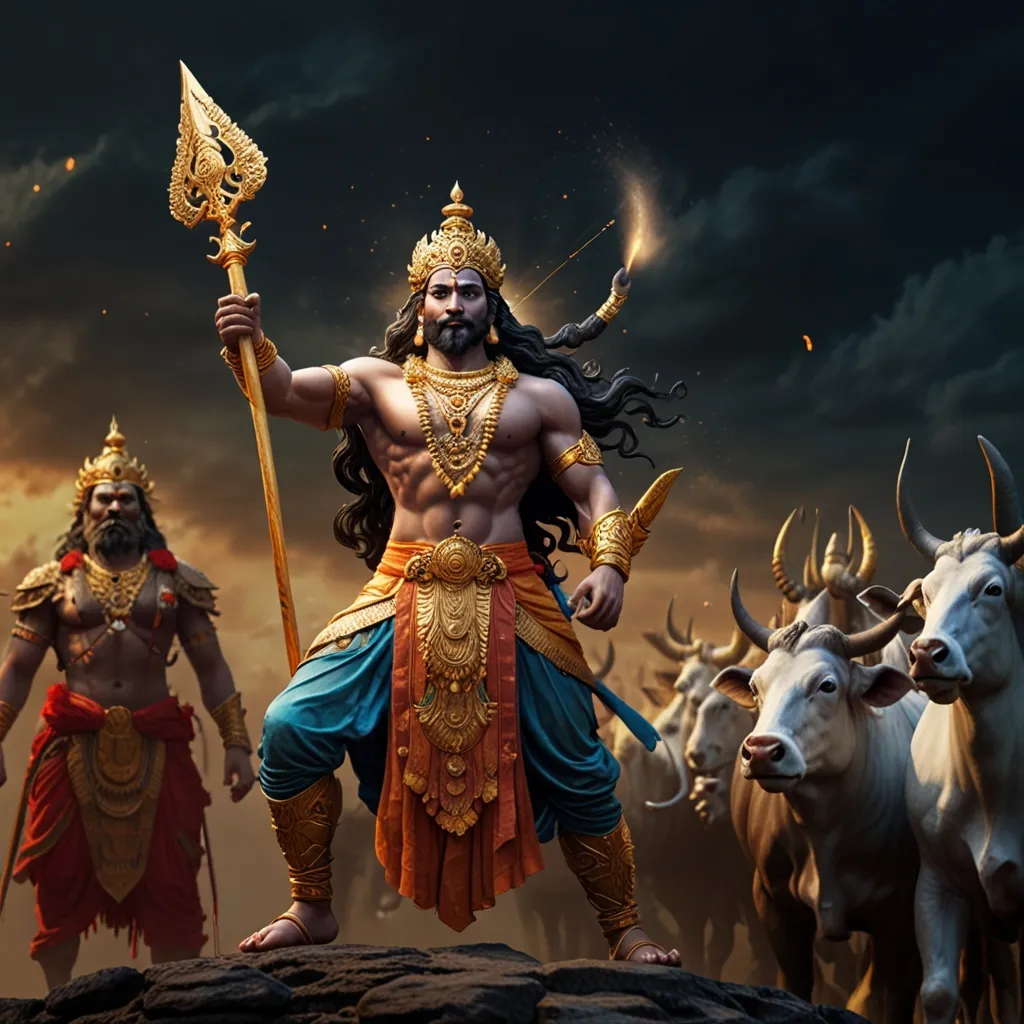In the legendary saga of the Mahabharata, one of the most intriguing and multifaceted characters is Gandhari, the princess of the Gandhara Kingdom. Her tale is a mesmerizing mix of strength, loyalty, and the inexorable pull of fate that intertwines her destiny with that of the Kuru dynasty. The journey of Gandhari begins with her marriage to Dhritarashtra, the eldest prince of the Kuru Kingdom, a bond that would forever alter the destinies of both their families.
Gandhari, daughter of King Subala and Queen Sudharmaa, hailed from the kingdom of Gandhara. Known for her piety and elegance, her life took a dramatic twist when she was betrothed to Dhritarashtra, a blind prince. This match was put together by Bhishma, Dhritarashtra’s granduncle, in an effort to ensure the future stability of the Kuru throne. Bhishma’s choice was swayed by a divine boon bestowed upon Gandhari, granting her the ability to bear a hundred children, ensuring the Kuru lineage would flourish.
Discovering her future husband’s blindness was a pivotal moment for Gandhari. In a profound display of love and solidarity, she decided to blindfold herself, a gesture that resonated far beyond mere devotion. This act was also her silent protest against the imposed power dynamics that led to her arranged marriage. By choosing to live in perpetual darkness, Gandhari made a powerful declaration against societal norms that shaped her fate.
Gandhari’s blindfold became more than a physical covering; it symbolized her unyielding commitment to Dhritarashtra and her subtle resistance against the patriarchal structures surrounding her. Her conviction remained steadfast, even as she grasped the full impact of her husband’s blindness and the challenges it brought. Embracing her new reality with valor and resolve, she prepared to confront the trials that lay ahead.
Their marriage faced many hurdles. Dhritarashtra’s blindness meant he couldn’t claim the throne initially, ceding it to his younger brother, Pandu. Fate intervened when Pandu was cursed by Sage Kindama, leading him to abdicate and retreat from the kingdom. Consequently, Dhritarashtra ascended the throne of Hastinapura, with Gandhari as his queen.
As queen, Gandhari’s role went beyond ceremonial duties. She was a force to be reckoned with—a clever and capable woman significantly impacting the political and social fabric of the kingdom. Despite her sons being cast as antagonists in the saga, Gandhari consistently urged them towards righteousness and reconciliation with their cousins, the Pandavas. Unfortunately, her efforts were frequently undermined by her brother, Shakuni, who harbored a deep-seated grudge against the Kuru dynasty for coercing his sister into marriage.
Motherhood was perhaps the most defining chapter of Gandhari’s life, for she bore a hundred sons, collectively known as the Kauravas, and a daughter, Duhsala. Her sons were central figures in the Mahabharata, their actions steering events towards the monumental war of Kurukshetra. Despite her deep affection for her children, Gandhari maintained a staunch anti-war stance, refusing to bless her sons for the impending conflict and continuously advocating for peace and justice.
The Kurukshetra War was a shattering episode in Gandhari’s life. She witnessed the decimation of her family and the tragic end of her sons. Consumed with sorrow and anger, she cursed Krishna, who played a pivotal role in the war, forecasting the downfall of his Yadu dynasty. This curse was a manifestation of her profound grief and the deep sense of betrayal she felt from a world that had taken everything from her.
After the war, Gandhari, alongside her husband Dhritarashtra, brother-in-law Vidura, and sister-in-law Kunti, embarked on a journey of penance. This pilgrimage marked the final chapter of her life, filled with contemplation, penance, and the quest for spiritual solace.
Gandhari’s story is a saga of unwavering love, immense sacrifice, and tenacious resilience. Her lifelong blindfold is a metaphor for her steadfast devotion to her husband and her quiet rebellion against societal dictates. She endures as one of the most compelling figures in the Mahabharata, embodying the incredible strength and courage of women facing overwhelming adversities.
In reflecting on Gandhari’s life, it’s hard not to feel a deep sense of empathy for the trials she endured. The decision to blindfold herself seems almost inconceivable in our modern context, yet it underscores the impressive depth of her love and commitment. Her life was dictated by external forces—divine boons, royal decrees, and societal expectations—but within these constraints, she exhibited an extraordinary degree of agency and resolve.
What stands out about Gandhari is her layered complexity. She wasn’t just a loving wife or a nurturing mother; she was also a formidable queen with a keen understanding of politics and statecraft. Even as she dealt with her own profound challenges, including the sabotage of her brother Shakuni, she remained steadfast in her advocacy for dharma—a commitment to righteousness and justice.
In the grand tapestry of the Mahabharata, Gandhari’s sorrow is palpable. Whether it’s the unimaginable grief of losing all her sons or her final journey towards penance, her story pulls at your heartstrings. In every thread of her narrative, there’s a universal theme of the human condition—love, loss, strength, and the relentless search for peace.
Gandhari’s curse on Krishna is another aspect that adds depth to her character. This act wasn’t just born out of pain but also from a place of profound disillusionment. Even divine entities weren’t immune to her grief and anger, highlighting the intense emotional wounds inflicted upon her.
As we revisit these ancient tales, Gandhari’s story remains incredibly relevant. Her life serves as a powerful reminder of the strength and resilience that women possess. Despite the layers of ancient culture and myth, Gandhari’s inner conflict and unwavering resolve resonate with anyone who has faced similar struggles, making her a timeless figure of inspiration.
The lessons from Gandhari’s life invite reflection: how societal norms shape individual destinies, the quiet strength required to challenge these norms, and the power of unwavering commitment in relationships. But perhaps most importantly, Gandhari symbolizes the resilience of the human spirit. She stood firm even when her world crumbled around her, making her one of the most enduring heroines of the Mahabharata.






